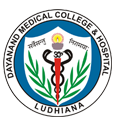DAYANAND MEDICAL COLLEGE & HOSPITAL, LUDHIANA 17th August,2012
Lecture held on 'Proper Documentation of Death Certificate'
To sensitize the intern and resident students about the importance of medical certification of cause of death and to improve recording of the cause of death, a guest lecture on 'Death Certification' by Dr BL Meel from South Africa was held at DMCH.
According to Dr Meel, Proper Death Certification begins with a fundamental understanding of the cause and manner of death. During the process of medical certification of the cause of death, it is incorrect to simply write “heart failure,” “cardiac failure,” “cardiopulmonary arrest”, “respiratory arrest” and “brain death” without mentioning the underlying cause of death of the patient. In cases where the cause of death is unknown, body should be subjected for medico-legal or clinical autopsy to ascertain the cause of death depending upon the circumstances.
According to the legal provisions made in the Registration of Births and Deaths Act, 1969, the certification of the cause of death by a medical practitioner who has attended the deceased during the latter’s last illness is necessary. All extracts given in Death Certification Report should be certified by the registrar.
In cases of suspicious, unnatural deaths and other medico-legal cases in which medico-legal autopsy is indicated, the last attending medical practitioner should not issue the “death certificate,”. The case should be informed to the police and the dead body should be kept in safe custody till it is forwarded for medico-legal autopsy by the legal procedure.
Dr Gautam Biswas (Prof & Head of Forensic Medicine) also informed that the death certificate should be filled properly as per WHO guidelines. This will help to collect the statistical data. The certificate consists of two parts--Part I describes the condition(s) that led directly to death (immediate cause). It is divided further into subsections and generally three—(a), (b) and (c). These are for disease processes that have led directly to death and that are causally related to one another,(a) being due to or consequent on (b), which in turn is due to or consequent on (c) (antecedent causes). Part II is for other conditions, not related to those listed in Part I, that have also contributed to death(contributory cause). |







